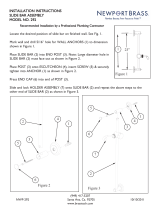MAINTENANCE
5.2.2 HYDRAULIC CLOSING
1. Push the mobile head into contact with the
plate pack.
2. Install the four tie rods (Item 0, Figure 18) and
adjust them so that they project at least 18" out
from the face of the fixed head, to allow instal-
lation of the hydraulic cylinders.
3. Mount the four hydraulic cylinders (fully
closed) at the fixed-head end.
4. Install the nuts (Item L, Figure 18).
5. Activate the hydraulic pump and allow the
cylinders to tighten the plate pack.
3. Tighten the plate pack using diagonally oppo-
site tie rod pairs, in a sequence similar to that
given in Figure 19 below. Ensure during clos-
ing that the fixed and mobile heads are kept
parallel to each other to within 1/4" to 1/2".
4. Install and tighten the remaining tie rods and
ensure that all tie rods are under tension.
5. If the plate gaskets are reused, the tightening
dimension should be between the recorded
dimension "A" and the minimum tightening
dimension given in the General Assembly
drawing, provide the number of plates is
unchanged. If new gaskets are used, the
tightening dimension should be within the min-
imum and maximum allowable dimension
given in the General Assembly drawing.
6. After final tightening, the fixed and mobile heads
must be parallel to within 1/16" in all dimensions
to ensure proper plate pack alignment.
13
Fig. 19: Example of manual
tightening sequence
6. Shut off the hydraulic pump, maintaining the
cylinders under pressure.
7. Install the remaining tie rods and tighten them
by hand.
8. Release the pressure from the hydraulic cylin-
ders. When rams have fully retracted from the
nuts, tighten the nuts against the mobile head.
9. Re-activate the hydraulic pump and repeat the
procedure until the required tightening dimen-
sion is reached. If old gaskets are still used,
the tightening dimension should be between
the recorded dimension and the minimum
tightening dimension indicated in the General
Assembly Drawing (provided that the number
of plates remains as per the original design). If
new gaskets have been applied, then the tight-
ening dimension should be no larger than the
maximum specified on the General Assembly
Drawing, and no smaller than the minimum
specified.
10. Finish tightening the tie rod nuts (Items L or J)
with a wrench. The fixed and mobile heads
must be parallel to within 1/16" in all direc-
tions, to ensure proper plate pack alignment.
11. Remove the hydraulic cylinders and tighten
the four remaining tie rods.
12. The unit is ready for hydrotest.
5.3 RE-GASKETING
Triangle Tube plate heat exchangers, depending
on model and materials of construction, are avail-
able with glued or glueless gasketing systems.
Please consult Triangle Tube Engineering to veri-
fy the gasketing system used.
When replacing a significant number of
gaskets, consider replacing the entire set.
The sealing properties of gaskets under
compression diminish over time, and this
determines the amount of tightening that
will need to be applied to the plate pack
when closing the exchanger. Mixing of old
and new gaskets, therefore, will cause
over-compression of the new gaskets,
severely reducing their service life.
CAUTION
























